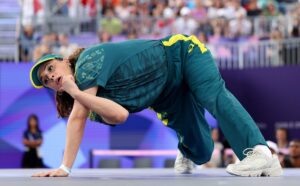A portrait of English mathematician Alan Turing became the first artwork by a humanoid robot to be sold at auction, fetching US$1.08m (£566,000, A$1.63m) in New York on Thursday.
The 2.2 meter (7.5 ft) portrait, titled AI God. Portrait of Alan Turing, was created by Ai-Da, the world’s first ultra-realistic robot artist. It smashed pre-sale expectations of between $120,000 and $180,000 when it went under the hammer at Sotheby’s, which confirmed 27 bids had been placed on the work.
“Today’s record sale price for the first artwork by a humanoid robot artist to go to auction is a moment in the history of modern and contemporary art and reflects the growing intersection between AI technology and the global art market,” the auction house said. . said in a statement.
Ai-Da, who uses AI to speak, said, “The key value of my work is its ability to serve as a catalyst for dialogue about emerging technologies.”
Ai-Da added that a “portrait of pioneer Alan Turing invites viewers to ponder the God-like nature of AI and computing while considering the ethical and societal implications of these advances.”
Turing, a mathematician and early computer scientist who played a crucial role in the fight against Nazi Germany by working as a code breakerraised concerns about the use of AI in the 1950s.
One of the most advanced robots in the world, Ai-Da is designed to look like a human woman and is named after Ada Lovelace, the world’s first computer programmer.
Ai-Da was designed by Aidan Meller, a specialist in modern and contemporary art.
“The greatest artists in history grappled with their period, both celebrating and questioning society’s shifts,” Meller said.
Meller led the team that created Ai-Da, working with artificial intelligence specialists at the universities of Oxford and Birmingham.
Ai-Da generates ideas through discussions with members of the studio, and suggested creating an image of Turing during a discussion about “AI for good”.
The robot was then asked what style, color, content, tone and texture to use, before using cameras in its eyes to look at a picture of Turing and create the painting.
The artwork’s “muted colors and broken facial planes” seemed to suggest “the struggles Turing warned we would face when it comes to managing AI,” Meller said.
Ai-Da’s works were “ethereal and haunting” and “continue to question where the power of AI will take us, and the global race to harness its power”, he added.
In an interview with the Guardian in 2022when asked if she painted from imagination, Ai-Da replied: “I like to paint what I see. You can paint from imagination, I think, if you have an imagination. I saw different things for people, since I have no consciousness.”
Agence France-Presse contributed to this report




